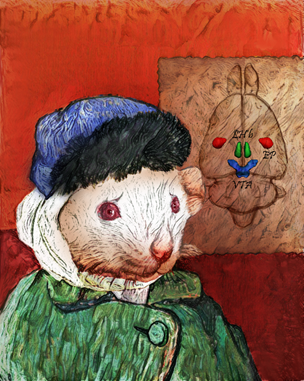
Adapted from Self-Portrait with Bandaged Ear and Pipe(Draw by TANG Xun)
Self-injurious behavior (SIB) is often defined as the destruction or alteration of body tissue that occurs in the absence of conscious suicidal intent. It is commonly observed in patients with neuropsychiatric disorders, as well as nonclinical populations with stress related mental health problems. SIB occurs in about 4% of the general population, with substantially higher occurrence among adolescents and patients of neuropsychiatric disorders. However, the exact circuitry mechanisms underlying SIB have remained unclear.
Researchers established a rat model of SIB with bilateral injection of muscimol into entopeduncular nucleus (EP). Following the muscimol injection, the male rats exhibited stereotypic self-biting behavior that lasted for hours and often resulted in wounds of various severities, in a dose-dependent manner. Researchers found that the SIB was associated with elevated level of serum corticosterone, and could be exacerbated or alleviated by enhancing or inhibiting the corticosterone signaling, respectively.
Combined with viral tracing and c-fos immunostaining, researchers revealed the involvement of various subcortical areas and firstly drew a brain areas map that relates to SIB. Furthermore, medicinal regulating activity in SIB demonstrates the affective circuit in modulating SIB. The results suggest potential targets for therapeutic intervention of SIB and related disorders.
Two doctoral students, GUO Yujie at Hefei National Laboratory for Physical Sciences at the Microscale and TANG Xun at USTC School of Life Sciences and CAS Kunming Institute of Zoology (KIZ) are the co-first authors of this paper, with Prof. LIU Beiming of USTC, research fellow XU Lin of KIZ as correspondents. This work was supported in part by the Strategic Priority Research Program of the Chinese Academy of Sciences, the National Science Foundation of China, the National Basic Research Program of China, and the People's Government of Yunnan Province.
This paper is published on Journal of Neuroscience with title Corticosterone signaling and a lateral habenula-ventral tegmental area circuit modulate compulsive self-injurious behavior in a rat model.
Link of the paper:http://www.jneurosci.org/content/early/2018/05/14/JNEUROSCI.2540-17.2018
(Edited by XU Yue)
Contact:
FAN Qiong
Tel: +86-63607280
E-mail:englishnews@ustc.edu.cn